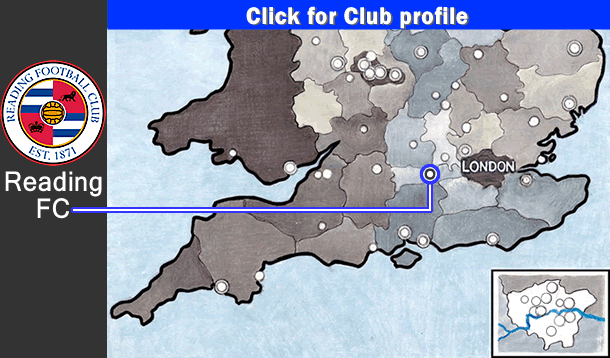
Reading Football Club was formed in 1871. The club remained amatuer for it’s first 24 years, and was a founding member of the Southern League, in 1894. In 1895, they turned professional. Reading’ s nickname throughout it’s first century was “the Biscuitmen,” after a local industry. (They changed their nickname to the Royals in the 197o’s, as a reference to Berkshire’s status as the Royal County; Windsor Castle is located there.) The highlight of their early days was a tour of Italy in 1913, where they defeated Genoa, AC Milan, and champs Pro Vercelli. Reading was elected to the League in 1920, as part of a group of teams allowed to join, to fill the new Third Division. They moved up to the Second Division in 1926, but only remained there for five seasons. 33 seasons (1931-1971) in the Third Division followed. For the next 13 seasons, they vacillated between the 4th and 3rd Divisions. In the 1982-83 season, the club was under the threat of dissolution. Robert Maxwell, the nefarious press-baron, had recently bought the nearby club Oxford United, and tried to bring about a merger of the two clubs, as the Thames Valley Royals. Supporters of both clubs were successful in preventing this. The club won the Third Division in 1986, and reached the second tier of English football for the first time in 55 years. However, they were relegated 2 seasons later.
In 1990, John Madejski bought the club. He had made his fortune publishing a second-hand car magazine. Five years into the new ownership, results could be seen: a doubling of the fan base (from 4,000 to 9,000 average attendance), and a return to the second tier. In fact, had it not been for the streamlining of the Premier League, in 1995-96 (from 22 clubs to 20), Reading would have been automatically promoted. Madejski has said, in retrospect, that this would ultimately have impeded the club’s progress, as their new stadium was not ready, and they surely would have gone straight back down. As it was , the Royals did have another set-back, 4 seasons back down in the third level (1998-2002), before their next assault on the top flight. By 2003, Reading was drawing 16,000, and their small-club days looked to be behind them. Steve Coppell, a former Manchester United and England winger, took over from Alan Pardew, who left acrimoniously to West Ham. A 7th place finish in 2005 was followed up by a record-breaking run: Reading clinched promotion to the top flight (on March 25, 2006) quicker than any club in the post-War era. The next season, Reading’s first ever in the top flight, saw an essentially unchanged squad. And not one player on the squad had a single game of Premier League experience. Under the steady leadership of Coppell (see this article), and with very vocal and enthusiastic sell-out crowds behind them, Reading produced a string of results that saw them finish one point shy of qualifying for the UEFA Cup. Under Madejski, and with Coppell, Reading had gone from a century-old football backwater struggling in the lower divisions, to 8th place in one of the 3 top leagues in the world. From barely drawing 4,000 paid customers, to a sold out 24,000 seat stadium, with plans for expansion to 36,000, all in under 20 years.
Thanks to Historical Football Kits (historicalfootballkits[dot]co[dot]uk) for the older kits (the 5 kits on the lower left of the chart), which are reproduced by kind permission. Thanks to Colours Of Football, and Some People Are On The Pitch for the newer kits. Thanks to (stadiums[dot]football[dot]co[dot]uk) and (readingfcpremiumtv[dot]co[dot]uk) for photos.
